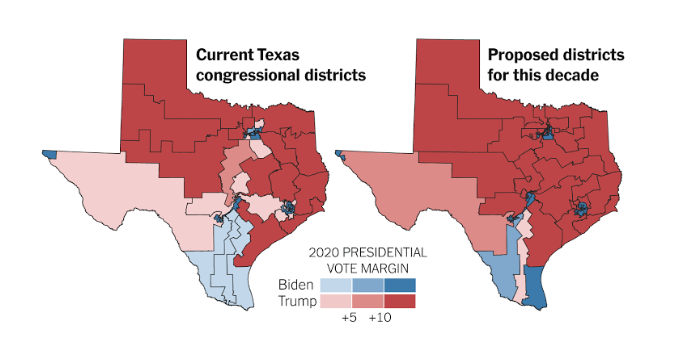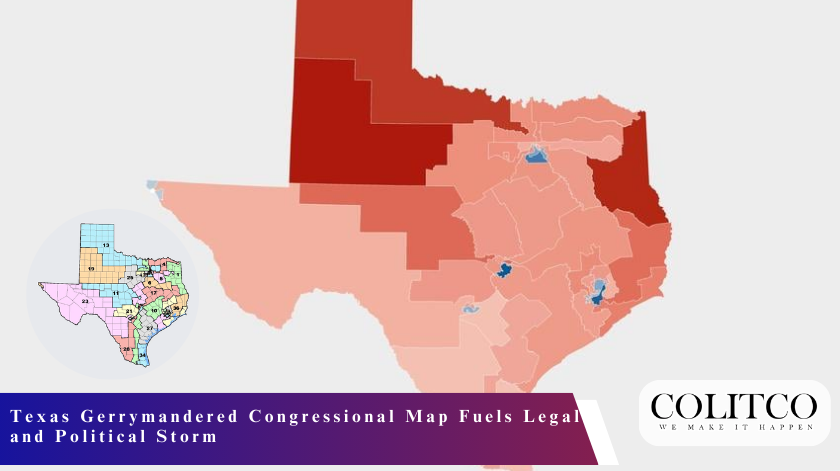On August 20, 2025, the Texas House passed the controversial congressional redistricting plan, which showed stark political division via an 88-52 party-line vote. It marked a rare occasion of mid-decade redistricting, one the former president Donald Trump largely pushed forward.
Democrats tried a walkout lasting two weeks to stall the vote. This temporarily robbed the Republicans of a quorum and delayed debate on the matter but did not manage in stopping it altogether.
The new map now heads toward the Texas Senate, where Republicans also enjoy a majority. Governor Greg Abbott has already given an indication that he intends to sign the measure into law.
Republicans characterised the plan as a necessary step in securing control of key districts. Demographic shifts, they claimed, demanded new boundaries, though critics quickly saw through the pretext.

Texas redistricting plan
The Map Targets Five Democratic Seats
At the heart of the dispute are five Democratic-held districts that could be flipped under the new redistricting. The districts of incumbents Al Green, Henry Cuellar, Julie Johnson, Vicente Gonzalez, and Greg Casar have now been carved up to split Democratic voters.
Analysts suggest the slicing of the map maintains Republican areas while breaking apart districts heavy with minority voters. If the plan were successful, it would allow Republicans to win as many as five districts in the 2026 midterm elections.
The stakes are very high. Republicans hold a very slight majority in the U.S. House of Representatives. Any small gain coming from Texas seats would considerably strengthen the further road for them ahead toward the 2026 election.
Democrats have expressed concern that these changes could distort fair representation and erode voters’ trust. So the map is no longer merely a state issue but a national battle for Congress.
Why Do Critics Call It Racial Gerrymandering?
Civil-rights groups and Democratic leadership maintain that the congressional map gerrymandered by Texas infringes the Voting Right Act. Their line of argument is that these lines dilute voting strength of Black, Latino, and Asian American communities.
Democrats hold Republicans responsible, alleging the latter undertook deliberate measures to fracture urban districts in a manner diminishing minority influence. They contend that the design unfairly consolidates minority populations into uncomfortably large, Republican-leaning constituencies.
Republicans reject the accusations. They contend that under the new map, there will be more Hispanic-majority districts than ever before. They uphold that the changes instead simply represent population shifts rather than discriminatory intent.
Given that, challenges to the courts should be imminent. Democratic lawmakers and advocacy groups are preparing to file lawsuits. Months of court battles are predicted and may extend into judicial review of 2026 elections.
This Escalates a National Redistricting Battle
The Texas move has set off a bigger fight over redistricting across the United States. Democrats in California under the leadership of Governor Gavin Newsom have signalled that they will bring forth their own map. This proposed plan was to add five Democratic-leaning districts, balancing out the Republican gains of Texas.
Former president Barack Obama has bestowed his endorsement on California’s plan. He saw it as fighting for democracy against partisan gerrymandering. For Obama and his allies, the stakes are far beyond Texas or California. They see this fight as central to the long-term balance of power in Congress.
The Republicans dismiss those claims. They say that Democrats are doing what they accuse them of, thus redistricting fights are matters of political self-interest on both sides.
What Will Happen Next?
The immediate next step is in the Senate in Texas. With Republicans holding the majority, the approval is expected to go through. Governor Abbott has indicated that he would sign the measure swiftly upon its passage.
With the signature in place, lawsuits shall ensue. The courts decide whether the map stays as it is or is to be changed. Federal judges have historically been a dominant force in Texas redistricting fights. The ruling would affect not just the 2026 election, but also political representation into the rest of the decade.
So, for voters, uncertainty is in the air. Should the courts intervene, districts may be changed again before any ballots are cast. Candidates would then have to adapt to changes in boundaries and the demographic makeup.

Texas state Senator Carol Alvarado
High Stakes for the 2026 Mid-Terms
If the map holds up under court scrutiny, Republicans will certainly have a better chance of consolidating their hold on all 38 seats in the Texas Congressional delegation. Even a gain of three to five seats may tip the balance of power in the House.
For Democrats, this is considered an important struggle with symbolic value. They argue that the Texas heavily gerrymandered congressional map belies the very idea of democracy by eroding fair representation. Civil-rights groups emphasise the risk of minority voices being muffled in a demographically diversifying state.
In fact, the 2026 midterms are fast being transformed into a referendum on redistricting. Both parties view state maps as crucial weapons in a greater war for power. This Texas case is very likely to become a national handbook to show how far political leaders are willing to push the envelope to cement electoral advantage.
Also Read: March Madness Sweet 16 Delivers Thrilling Clashes as Elite Eight Takes Shape
Conclusion
The gerrymandered congressional map of Texas is more than just a state policy crisis. It has become a political battle at the national level, with far-reaching repercussions on balancing power in Washington.
From the Republican viewpoint, the gerrymander is an absolute necessity to keep their majority, while Democrats view it as an assault on minority representation and democratic norms. Well into the lawsuit phase and other states joining in turmoil, this outcome will ring far beyond Texas. While the map inches along for final approvals, the 2026 midterms still hang in the balance.












